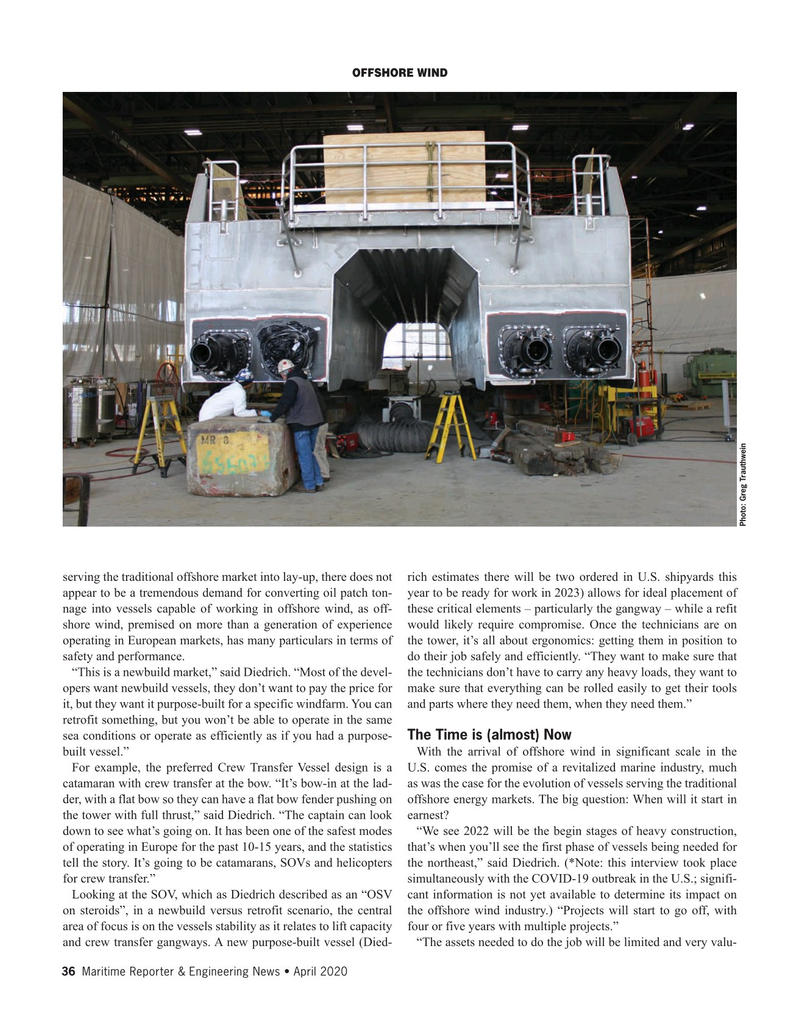
Page 36: of Maritime Reporter Magazine (April 2020)
Offshore Energy Edition
Read this page in Pdf, Flash or Html5 edition of April 2020 Maritime Reporter Magazine
OFFSHORE WIND
Photo: Greg Trauthwein serving the traditional offshore market into lay-up, there does not rich estimates there will be two ordered in U.S. shipyards this appear to be a tremendous demand for converting oil patch ton- year to be ready for work in 2023) allows for ideal placement of nage into vessels capable of working in offshore wind, as off- these critical elements – particularly the gangway – while a refit shore wind, premised on more than a generation of experience would likely require compromise. Once the technicians are on operating in European markets, has many particulars in terms of the tower, it’s all about ergonomics: getting them in position to safety and performance. do their job safely and efficiently. “They want to make sure that “This is a newbuild market,” said Diedrich. “Most of the devel- the technicians don’t have to carry any heavy loads, they want to opers want newbuild vessels, they don’t want to pay the price for make sure that everything can be rolled easily to get their tools it, but they want it purpose-built for a specific windfarm. You can and parts where they need them, when they need them.” retrofit something, but you won’t be able to operate in the same
The Time is (almost) Now sea conditions or operate as efficiently as if you had a purpose- built vessel.” With the arrival of offshore wind in significant scale in the
For example, the preferred Crew Transfer Vessel design is a U.S. comes the promise of a revitalized marine industry, much catamaran with crew transfer at the bow. “It’s bow-in at the lad- as was the case for the evolution of vessels serving the traditional der, with a flat bow so they can have a flat bow fender pushing on offshore energy markets. The big question: When will it start in the tower with full thrust,” said Diedrich. “The captain can look earnest?
down to see what’s going on. It has been one of the safest modes “We see 2022 will be the begin stages of heavy construction, of operating in Europe for the past 10-15 years, and the statistics that’s when you’ll see the first phase of vessels being needed for tell the story. It’s going to be catamarans, SOVs and helicopters the northeast,” said Diedrich. (*Note: this interview took place for crew transfer.” simultaneously with the COVID-19 outbreak in the U.S.; signifi-
Looking at the SOV, which as Diedrich described as an “OSV cant information is not yet available to determine its impact on on steroids”, in a newbuild versus retrofit scenario, the central the offshore wind industry.) “Projects will start to go off, with area of focus is on the vessels stability as it relates to lift capacity four or five years with multiple projects.” and crew transfer gangways. A new purpose-built vessel (Died- “The assets needed to do the job will be limited and very valu- 36 Maritime Reporter & Engineering News • April 2020

 35
35

 37
37
